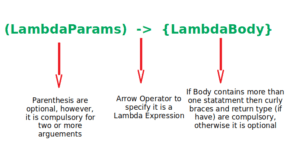Lambda expression is one of the core feature introduced in Java 8 as it provides a way to achieve functional programming in an object oriented programming language. It is anonymous function without having modifiers and return type. In other words, it simply provides a definition to a single abstract method defined within an interface called as Functional interface.
Point to remember:
– It provides a way to achieve functional programming in Java
-A Lambda expression is anonymous function having no modifiers and return type.
– It uses functional interfaces as its base to implement functional programming in Java. Without functional interface it cannot be implemented.
-It uses arrow operator or lambda operator to tell the compiler it is a Lambda expression
Syntax:

These are following features of a lambda expression:

– No return type: Unlike function, in lambda expression, we don’t provide the return type. We simply write () -> {}
– No Modifiers: Another important aspect of Lambda expression is, no modifier is required to mention.
The above two aspects indirectly depends on abstract method of a functional interface. Lambda Expression indirectly references to that type.
– Optional Argument type : It is not mandatory to provide datatype to the parameter, but if one does then parenthesis would be mandatory
– Optional Parenthesis : if there is a single argument then putting parenthesis would be optional
– Optional curly braces and return type : if there is a single statement in the expression body then there is no need to put curly braces and return statement(if have).
Before Lambda Expression:
create a function:
void cube(int x) {
System.out.println("cube :"+ x*x*x);
}create an object to call that function:
Test obj = new Test();
Invoke it
obj.cube(3);
After Lambda Expression:
Import Function (A predefined functional interface)
import java.util.function.Function;
Create a Lambda expression:
Function<Integer,Integer> cube = x -> x*x*x;
call its apply abstract method
System.out.println("This is the cube of "+ x + ":"+ cube.apply(x));